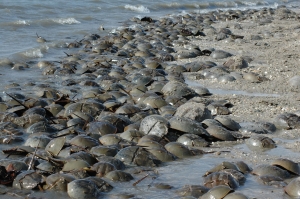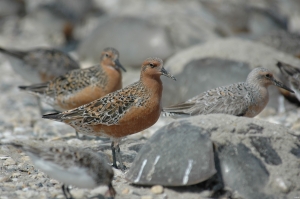Today Ira Flatow discussed summer science reads on Science Friday, my favorite radio program. So, I got to thinking about two very special books that I always wander back to when I want to reconnect with the ocean. Henry Beston’s, The Outermost House, and Jennifer Ackerman’s, Notes from the Shore, are two books written in the spirit and tradition of Thoreau’s, Walden. Beston and Ackerman are alone with their thoughts in a remote marine environment (Beston is on Cape Cod while Ackerman is on Delaware’s Cape Henelope) for an extended period of time. They both contemplate how the ocean can be a metaphor for our existence.
After his return from World War I, Beston built a writer’s cabin on Cape Cod. He called the home Fo’castle and there he wrote The Outermost House published in 1928. This book was an inspiration to Rachel Carson as she wrote The Sea Around Us. Fo’castle was unfortunately destroyed by high tides in 1978.
Here is an excerpt from The Outermost House that I come back to often (especially when I am coveting the latest smartphone): “Touch the earth, love the earth, her plains, her valleys, her hills, and her seas; rest your spirit in her solitary places. For the gifts of life are the earth’s and they are given to all, and they are the songs of birds at daybreak, Orion and the Bear, and the dawn seen over the ocean from the beach. ”
Let’s face it. Beston is not for everyone. Jennifer Ackerman is a bit most contemporary in her text and prose. After all, Notes from the Shore was published in 1995. Her outlook on man altering nature is spot-on, “It’s in our nature to see order and when we don’t see it, to try to impose it. We have to put things through our minds to make sense of them, and our minds crave pattern and order. So maybe what we glimpse is only what we desire.” A statement that reminds me sometimes we should just allow nature to take its course and see what happens.
her text and prose. After all, Notes from the Shore was published in 1995. Her outlook on man altering nature is spot-on, “It’s in our nature to see order and when we don’t see it, to try to impose it. We have to put things through our minds to make sense of them, and our minds crave pattern and order. So maybe what we glimpse is only what we desire.” A statement that reminds me sometimes we should just allow nature to take its course and see what happens.
Another reason I gravitate to Notes from the Shore is that she spends a considerable amount of time writing about my favorite animal, Limulus polyphemus. She even reviews her experience counting horseshoe crabs during the late nights in May and June, an activity this Beach Chair Scientist did quite often during undergraduate internships. With that I will leave off with Ackerman’s description on the incredible nature of the horseshoe crab‘s ability to remain so steadfast and unchanged, “These creatures so durable that they antedate most other life-forms, so adaptable that their survival as a species may, for all we know, approach eternity.”
Image (c) goodreads.com
Related articles
- It’s as Easy as A, B, Sea: A Review (beachchairscientist.wordpress.com)












What people are saying …